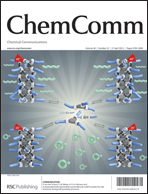Rational design of a NIR-emitting Pd(ii) sensor via oxidative cyclization to form a benzoxazole ring†
Abstract
By using the substituent effect to tune the palladium(II)-involved reactivity, a new probe is found to respond quantitatively to Pd(II). Unexpectedly, the probe gave an emission band in the desirable near-infrared (NIR) region (780 nm), thus providing the first NIR sensor for


 Please wait while we load your content...
Please wait while we load your content...